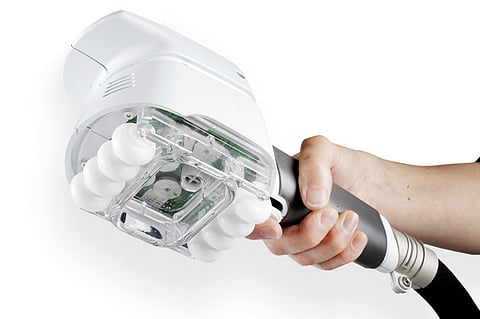Non Invasive Laser Lipo
By Hillary Latos
As technology has advanced in the field of weight loss, aesthetic recontouring has seen its share of evolutions that continue to improve in the field of non invasive techniques. The most successful and advanced non surgical fat reduction and body shaping system approved by the FDA comes from Chromogenex with their i-LipoXcell laser innovation.
HOW IT WORKS
i-LipoXcell uses four technologies to measure body fat, laser fat reduction, IR vacuum massage and radiofrequency skin tightening. By using the radio frequency heat it can stimulate metabolic activity and smooth out cellulite and tighten up loose skin giving a firmer looking result. The laser uses both a visible and infrared laser to release fatty acids and glycerol and shrink fat cells. Besides the procedure being painless without any downtime or recovery, the other advantage of this non surgical procedure is how it targets specific areas of stubborn fat while reshaping the body. The laser treatment is followed by a combination of laser and vacuum massage to stimulate lymphatic drainage, improve circulation and release cellulite causing fat cells. For the best results three to eight 20 minute sessions are encouraged alongside a healthy diet and exercise regime.
Here Resident speaks to healthy expert Dr. Jame Heskett from Wellpath to discover more about i-LipoXcell and what to expect.
Besides the obvious, what are the advantages of invasive vs non invasive lipo?
I think the most important thing with non invasive procedures is very little risk or downtime. Some people are ok with getting cut and getting anesthesia, and others are very adverse to it. For that whole group of people, as the technology has become so advanced, they are now able to get similar results to the invasive techniques. This technology has escalated tremendously in the last 5-7 years.
How do you manage expectations?
Because I've been doing this for so long I have a sensitivity to who comes into my office. What do they want to achieve and what are they interested in. What bothers them. Starting from that standpoint you can ask them questions to understand their expectations. You ask them what procedures they've had in the past, what they have considered doing, what are their concerns. I always promise less than what I think they are going to get, because you can't control what people do outside of your office. They may say they watch their diet and exercise like crazy but you don't know what they are doing. I always take it down a notch because that strategy generally works very well because almost everyone is satisfied. If you have predictable technology you can predict people's outcome regardless of what they may do outside.
What do you suggest for patients undergoing the i-LipoxCell as a lifestyle change?
I tell my patients this is a tool not a solution. Then I try to find out where and how are they exercising. What is their lifestyle now. Have they done anything in the past that have been beneficial without using a tool like this. Once I find out where they are at I try to make small incremental changes in their lifestyle and diet so those changes actually stick and are moving towards their eventual goal. It's about careful assessment and not telling people they have to make drastic changes because it's not sustainable. There are small things and tweeks that you can make in your diet, nutrition and physical activity that are easy to integrate into your lifestyle that can make a huge impact and can benefit from.
Do you see any kind of at home lipo treatments coming on to the market?
I would like to see something that can consistently stimulate the circulation. With our sedentary lives, this would be an easy at home remedy to adopt. I really think that would benefit anyone coming in for a treatment and facilitate people's big problems and produce faster results.
For more information:
ilipoxcell.com

